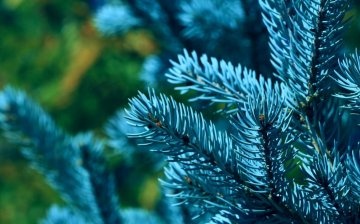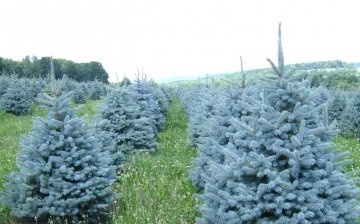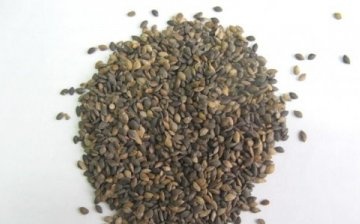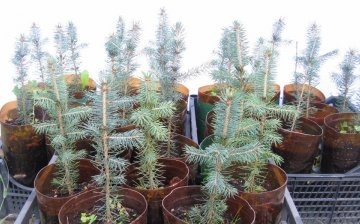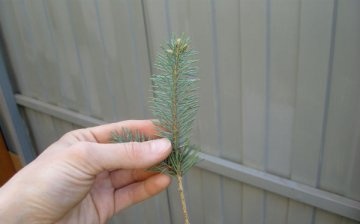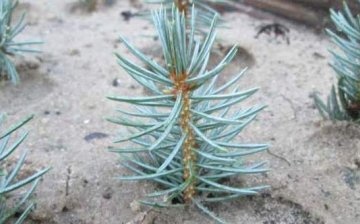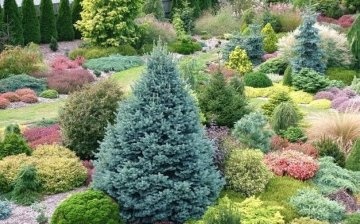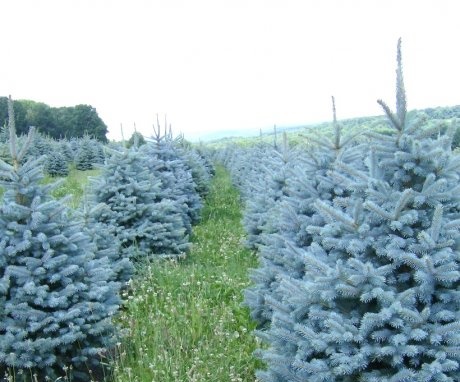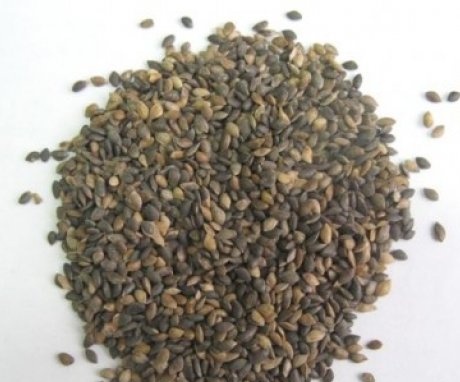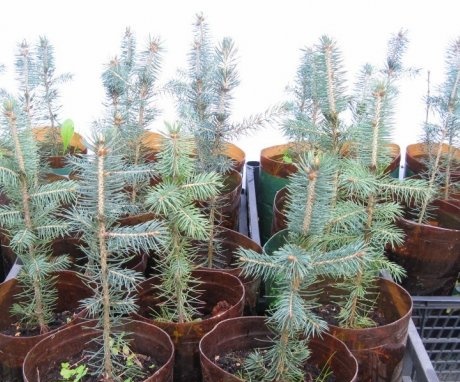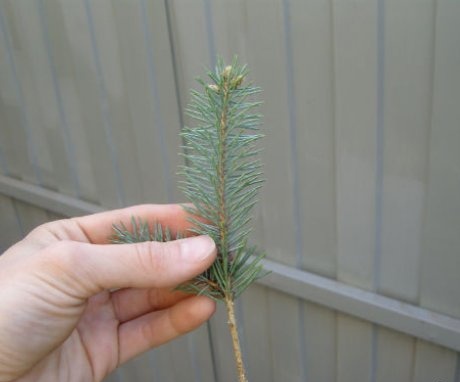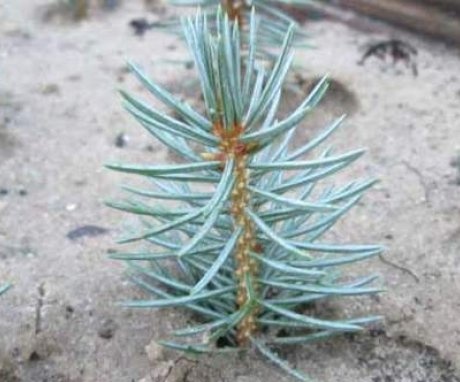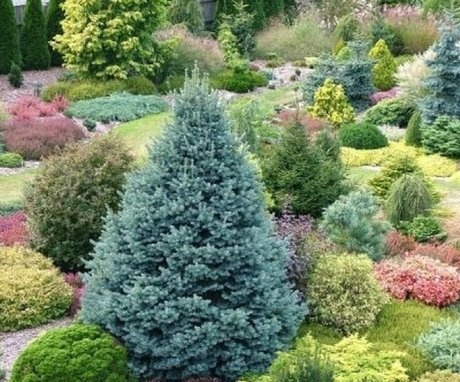How to properly plant a blue spruce on the site?
Blue spruce (prickly spruce Picea pungens) belongs to conifers. His homeland is North America. She attracts attention with the unusual color of her needles. How to grow a blue spruce yourself, at home?
Content:
- Blue spruce: description
- Reproduction of blue spruce seeds
- Sowing blue spruce seeds
- Growing blue spruce from cuttings
- Planting and caring for blue spruce
- Using blue spruce
Blue spruce: description
Blue spruce - a perennial tree, the height of which is up to 30 m. It grows by 8 cm per year. The trunk is straight, its diameter can reach one and a half meters. The branches branch off at right angles or rise slightly upward. The root is fibrous, located close to the soil surface.
The color of the needles is blue, silvery green, gray. The length of the needles depends on the variety, of which there are about 50 in nature, reaches 4 cm. It blooms in June. Cones form at the top of the tree. In November, they ripen and fall to the ground. In January, the scales open and the seeds fall out of them. The wind carries them long distances.
Decorative spruce varieties:
- Koster is a tree up to 10 m high. An old Dutch variety. Reproduces only inoculation.
- Blue Diamond (blue diamond) up to 7 m high, frost resistant, used in mixborders or to create hedges.
- Waldbrunn is a dwarf variety 80 cm high, 1 m wide. Forms a blue ball, used for rocky gardens, mixed rockeries.
- Bialobok is a tree up to 2 m high. The main color of the needles is silvery blue. Young needles are yellow. The crown grows unevenly, so all trees are of different shapes.
The blue spruce is propagated:
- Cuttings
- Seeds
Reproduction of blue spruce seeds
In order to grow a blue spruce from seeds, you need to find a beautiful tree with bright blue needles, on which cones have formed. Then you need to wait until they ripen. This takes place in early November. You need to get more cones. After all, the signs of the mother plant, and in this case the color of the needles is most of all interested, a third of the seedlings are transmitted. The rest will be blue-green or just plain green fir trees.
This is not easy to do, because you can get them by climbing closer to the top. Pluck young cones that have not yet opened. At home, they shake the seeds out of the buds. Usually they cut off the impeller on them, rubbing them with their hands. If there is no way to get to high-quality cones, they are looking for them under the tree. But there they are usually already opened, so it will be difficult to collect enough seeds.
Sometimes seeds are harvested in February, in which case they will need to be sown in the second half of June.
If the summer is very hot, the seeds will not germinate. Therefore, this method is only suitable for regions with a temperate climate. The harvested buds should open naturally. To do this, they create suitable conditions: high temperature and low humidity. You can install crockery with cones on a radiator, underfloor heating, stove or cupboard in the kitchen. After a few days, the bumps will begin to open. This will be reported by crackling scales. When they are all open, shake out the seeds by tapping on a hard surface. Spruce seeds can be purchased from the nursery.But their germination is lost over the years.
They remain suitable for cultivation no more than 2 years. The prepared seeds are washed in running water to get rid of essential oils, stratify... In natural conditions, they lie under snow until April. During this time, they are tempered. If the number of harvested seeds allows, they are divided into two parts, one is sown in the ground. They will be covered by snow and they will undergo natural stratification there. The second half is kept for up to 3 hours in a 1% solution of potassium permanganate. It is dried on paper, placed in a cotton cloth, and hidden in a glass jar. Installed in the refrigerator where it is colder. Leave until spring. In early April, the seeds are taken out, immersed in a solution of trace elements overnight. Dry.
Sowing blue spruce seeds
There are several ways to sow seeds in spring:
- In open ground. To sow seeds in the ground, they prepare a greenhouse. The soil for growing spruce must contain forest land, which contains the mycelium of the mushrooms, which helps the sprout sprout to germinate and rise. If it is not there, spruce grows poorly and often die. Lowland peat and coarse sand are added, ammophoska, dolomite flour. The prepared soil is tamped, seeds are spread on its surface. The distance between them should be about 4 cm. Only half of them germinate, so the seedlings will not be too dense. Sprinkle a thin layer of soil mixed with coniferous sawdust on top. Moisten, cover with a film, which is lifted every day for airing. After 21-25 days, seedlings will appear - if they are too dense, weak plants are removed. The distance between the remaining ones should be at least 6 cm. Spray 2 times a day, shade from direct sunlight. Young spruce trees grow in the greenhouse until next year. The temperature in the greenhouse should be around 15 ° C.
- Spruce is grown in containers with lids. The soil is a part of peat into 3 parts of sand. Fill the container two thirds. Moisten, sow seeds and slightly loosen the ground so that they do not remain on the surface. Close with a lid, set in a warm place protected from direct sunlight. When the seeds come up Open the lid for ventilation. Water it periodically. In the summer, they are taken out into the street and set in the shade. In winter they are kept indoors. Planted in open ground in May.
- Growing spruce in rolls does not require a lot of space. Prepare a substrate from under construction materials, cut it into ribbons up to 15 cm wide. Lay it out on a flat surface. Toilet paper is placed on top. Moisturize her. Seeds are laid out at a distance of 2 cm along the long edge. Sprinkle with a layer of earth. Fold the resulting tape into a roll, fix it with an elastic band so as not to disintegrate. Set so that the seeds are on top, moisten and cover with a film. Keep away from direct sunlight. They wait for the seeds to hatch. Then the film is removed and the plants are looked after as in the previous methods. Planted in May next year.
Growing blue spruce from cuttings
In order for the spruce to be blue, it must be grown from stalk... Harvesting them, young branches are not cut, but plucked together with the heel in the direction opposite to the direction of growth. With this method of preparation, the resin does not close the lumen and does not interfere with moisture passing along the branch. Cuttings are harvested in cloudy weather from fir trees, which are from 4 to 10 years old. They have a good survival rate. The length of one cutting is from 6 to 10 cm.
Cut cuttings are placed in a bag so that the tear-off site does not dry out, and they begin to root on the same day.
Before rooting, the cuttings are kept in a solution of root and antifungal agent. Planted in a greenhouse, covered with foil. Cuttings will take root in 1.5 months. If the root is not used, the root formation process will take up to 3 months.
You can germinate cuttings in the refrigerator or roll them.The refrigerator is used when the soil is not yet ready, and the cuttings may dry out. In this case, the root is not used. Cuttings are kept in it for 2 weeks at 3 degrees of heat, then planted in a greenhouse. You can grow cuttings in rolls. They are placed at a distance of 5 cm from each other, after having torn off all the needles from the areas that will fall under the paper.
Planting and caring for blue spruce
A greenhouse is prepared for planting cuttings. Do not use areas where nightshades or corn... This can provoke infection with a fungal disease.
Landing rules:
- A drainage layer is laid on the bottom. Its thickness should be at least 5 cm. The soil is prepared light.
- Cuttings are planted at an angle of 30 °, deepening by 2 cm.
- The distance from the cuttings to the "roof" - glass or film, is important. It must be at least 20 cm.
- Moisten the soil as needed. Correct watering is indicated by the absence of large drops of water on the glass. The greenhouse is ventilated every day.
- So that the sun's rays do not prevent the cuttings from taking root, the greenhouse is shaded for the first month.
Blue spruces are transplanted into open ground in early April. Do not allow the roots to dry out. Before planting, they are treated with a clay mash or MaxiMarin gel. When planting seedlings, the distance between the rows is 25 cm, between the plants 15 cm. When planting three-year-old blue spruces, the distance is increased to 1 m. After 3 years, they are transplanted to a permanent place. The soil must be added to the soil from the site where adult spruces grow.
The depth and width of the hole should be 25 cm wider and deeper than the root ball.
You need to water the transplanted spruce 12 times a year, even if the spring and summer were rainy. Watering is carried out with warm water. Adult blue spruces tolerate frost, drought well, and are not afraid of the wind. They can be planted in a city, because they are not afraid of high air pollution. But they grow very slowly. They do not like poor and dry calcareous soils. Grow well on moist fertile, slightly acidic soils. An exception may be undersized specimens.
It is better to plant blue spruce in a sunny place. In the early years they feed mineral fertilizers... They do it in March. While there is an opportunity, remove diseased and dry branches, form a crown. In summer, during a drought, blue spruce is watered, then the soil is loosened.
Using blue spruce
Blue spruces are valued for the beauty of their needles and their unusual appearance. Therefore, they are often planted near various institutions and buildings. But you can grow a blue spruce in your backyard. It is planted in a tapeworm, in single and group plantings. Its neighbors may be other coniferous or perennial flowering shrubs.
A blue spruce planted in the middle of a clearing can successfully replace a Christmas tree in winter. In order to be able to place garlands on it, it is better to plant it near your home.
More information can be found in the video:



